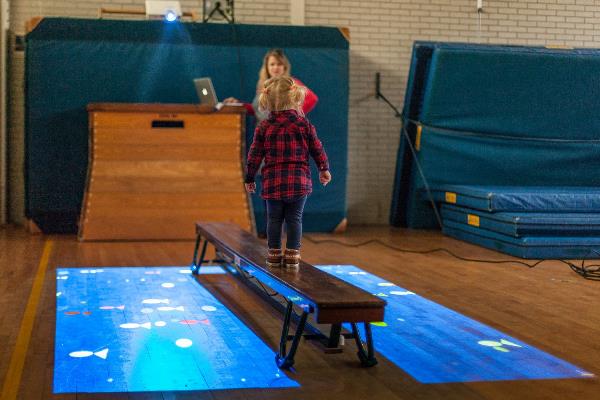Playful Exertion Interfaces
Playful interactive technology such as 'exertion games' can be helpful in getting children to exercise. These interfaces, which use the entire human body, are growing in popularity.
Centre of Expertise Health Innovation

Playful interactive technology such as 'exertion games' can be helpful in getting children to exercise. These interfaces, which use the entire human body, are growing in popularity. Take the piano stairs in an underground metro station, for example, or the Nintendo Wii. Previous research has shown that these interfaces also offer significant benefits such as encouraging social interaction. However, consciously using playful interactive technology requires more knowledge about its design and application.
The Healthy Lifestyle in a Supporting Environment research group is studying the design and use of these playful interfaces in public and semi-public environments. For example, museums are increasingly using interactive museum installations and amusement parks and municipalities are installing interactive play equipment such as a play zone or ball wall (Yalp). These have all been designed with the intention of teaching children something in a fun way and/or encouraging them to exercise.
Children who learn that exercise is fun and part of life are likely to get enough exercise later in life. Not every child learns this at home, but these children are often familiar with gaming and game consoles. So it will be interesting to see how technology that yields increasing possibilities for the body to control the computer can be used to its full potential.
Knowledge for better design
Playful interactive environments – Augmented Play Spaces (APS) – can encourage desirable behaviours such as physical activity and social interaction. These positive effects only occur if children actually use these interfaces. That is why we need more knowledge about the factors (including design aspects) that drive their use and the working mechanisms behind them.
Among other things, this research focuses on the use of 'Spatial Augmented Reality' (SAR), in which an extra layer of virtual information is added to physical reality, for example using projection, sound, movement or light.
The researcher wants to answer the following questions:
- What factors (including design aspects) influence the use of APS?
- In which participation phases do such factors play a role?
- How do these factors play a role in specific participation phases?
- What are the working mechanisms of these factors and design aspects?
- How can these factors be optimally designed/implemented?
Research approach
The researcher has used an exploratory approach with mainly qualitative research, supported by quantitative research. Using the researcher's approach of 'research by design', scientific knowledge is generated by the creation, iteration and evaluation of different experimental prototypes.
The project consists of several subprojects:
- A literature review about the use of factors that influence the use of playful interaction in public and semi-public spaces
- Interviews with experts
- Design and development of the Participant Journey Map (PJM)
- Observation of existing exertion interfaces to validate and evaluate the PJM
- Development of prototypes and pilots to test and evaluate these factors and design aspects
The new knowledge from this research can be applied to the design of exertion games, public play areas, school playgrounds, museum exhibitions and other public and semi-public environments.
Academic publications
- Mast, D., de Vries, S. I., Broekens, J., & Verbeek, F. J. (2021). The Participant Journey Map: Understanding the Design of Interactive Augmented Play Spaces. Frontiers in Computer Science, 3, 45.
- Mast, D., de Vries, S., Broekens, J., & Verbeek, F. J. (2020). The Importance of the Peak-End Rule for Repeated Visits to Augmented Play Spaces. In PERSUASIVE (Deputy).
- Mast, D. (2019, October). Social interaction in spatial augmented exertion interfaces. In Extended Abstracts of the Annual Symposium on Computer-Human Interaction in Play Companion Extended Abstracts (pp. 29-34).
Other publications
- Braun, B. (2019, 23 April). Alles op anderhalve meter – maar hoe dan?.Mare - Leids Universitair Weekblad .
https://www.mareonline.nl/wetenschap/alles-op-anderhalve-meter-maar-hoe-dan/ - Compagnie, A. (2020, 14 March). Researcher Danica Mast: ‘Kies liever voor een stip dan een vak in de anderhalve meter-samenleving’. AD Den Haag. https://www.ad.nl/den-haag/onderzoeker-danica-mast-kies-liever-voor-een-stip-dan-een-vak-in-de-anderhalve-meter-samenleving~ae058817/
- Vitale Delta (2019, November). Engaging people into participating in interactive augmented social
play spaces. Nieuwsbrief Sprong Vitale Delta. https://sway.office.com/Z7SRlCRVfYiP366Y?ref=Link
- Braun, B. (2019, 4 April). Meer dan schermpje staren. Mare - Leids Universitair Weekblad. https://www.mareonline.nl/wetenschap/meer-dan-schermpje-staren/
Duration
This project runs until mid 2024.